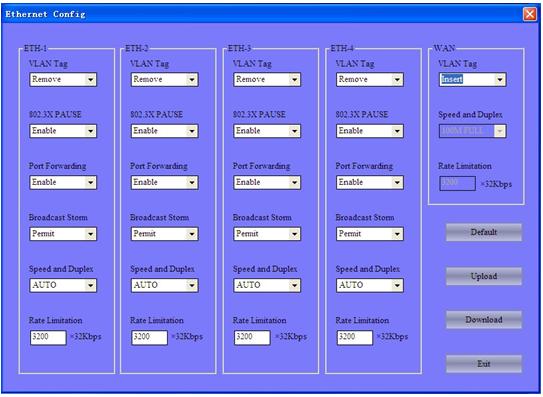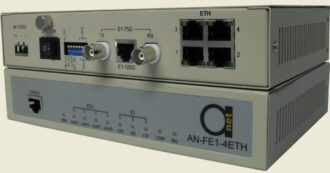Framed E1 to 4 Ethernet converter with Local Network Managment System
AN-FE1-4ETH Interface Converter (also as AN-FE1-4ETH Bridge) is an Ethernet bridge of high performance, which accomplishes the converting between the 4 x 100M Ethernet ports and the E1 port. Unit comes in set with user friendly NMS, which gives possibility to set dot1Q VLAN's, BW shaping and other features.
- In accordance with the provisions of IEEE 802.3、802.3u Ethernet, ITU-T G.703, G.704 and G.823 protocols.
- E1 interface framing/un-framing optional; balanced 120ohm unbalanced 75ohm optional.
- The E1 interface uses PCM31 mode, supporting CRC check.
- E1 interface main/ slave clock optional in the framing mode.
- In the E1 framing mode, the number of time slots is optional from 1 to 31.
- Supporting 2.048Mbps transparent transmission in the E1 un-framing mode.
- The two 100BASE-TX Ethernet interfaces support 100M half/ full duplex modes.
- MAC addresses self-learning and addresses filtering functions, reducing the transmission load of the E1 circuit.
- Built-in 64Mbits SDRAM Ethernet data buffer memory, improving the capability of Ethernet side anti-outburst, assuring high throughput of data transmission.
- E1 circuit remote loop and local loop tests
- Pseudo random sequence test, facilitating the test of E1 circuit.
- Perfect circuit test and alarm indication.
- Optional AC 220V or DC –48V input for bridge of both architectures
Protocols: G.703, G.704, G.736, G.823, I.431 IEEE802.3u 100BASE_TX
Circuit interface (E1):
Impedance: 75Ω, physical interface: BNC
Impedance: 120Ω, physical interface: RJ45
Interface rate: framing: N*64Kbps,N=0~31;
un-framing: 2.048Mbps。
Coding: HDB3,Jitter tolerance in accordance with G.823
Output jitter < 0.05UI
Data interface (100BASE_TX):
Impedance: 100Ω, physical interface: RJ45
Interface rate: 100Mbps
Coding: Manchester
Cable: 75Ωcoaxial-cable, UTP5 twisted pair。
Transmission range:
Circuit interface: BNC: 600m; RJ45: 300m
Data interface: 100m
Indicators:
indicating power, connection states of data and circuit interfaces, operation state, test state and trouble alarm.
Dimensions: 210mm (dep) x 140mm (wid) x40mm (hei)
Power supply: 85V~264V AC input, 5V/1A output
-36V~-72V DC input,5V/1A output
Power dissipation:3W
Operational temperature: 0℃~50℃
Storage temperature: -20℃~80℃
Humidity: 5%~90% (no condensation)
NMS system comes for free in set, screenshot from one of configuration windows is shown below:

Application scenario:
Testing and installation video, where we look at port isolation feature:
| AN-FE1-4ETH/AC | Framed E1 - 4 x Ethernet interface convertor, 75/120 ohm impedance, 220V, GUI NMS manager in set |
|
| AN-FE1-4ETH/DC | Framed E1 - 4 x Ethernet interface convertor, 75/120 ohm impedance, DC-48V, GUI NMS manager in set |
Description
AN-FE1-4ETH Interface Converter (also as AN-FE1-4ETH Bridge) is an Ethernet bridge of high performance, which accomplishes the converting between the 100M Ethernet port and the E1 port. As an extended device of the Ethernet, the AN-FE1-4ETH bridge realizes interconnection of four Ethernet by using the E1 channel provided by existing networks with low cost.
100BASE-TX (RJ45) interfaces are provided at the end of Ethernet LAN to accomplish various functions including double Ethernet interface broad band shared, MAC address self-learning, address filtering, address table maintenance and flow control. The device has 4 ETH port, it can work like an intelligent L2 switch. It can be reduce the net node, dispense with the device as HUB, consequently reduce the malfunction node.
The AN-FE1-4ETH has the GUI NMS, it can manage the converter like an intelligent L2 switch. It can set the TAG VLAN on these 4 ETH port, can set the special tag like Q-in-Q, can configurable data rate from 32K~100M on each ETH port, can do some Qos setting.
E1 interfaces conforming to ITU-T G.703 and G.704 proposals are provided at the end of WAN, supporting RJ45 and BNC connection modes. The E1 ports support both framing and un-framing architecture. The user can select an operating mode for the E1 interface according to the connected E1 environment. This provides flexibility of network application. In the framing mode, the E1 interface provides a rate of N*64Kbps(N=1~31). In the un-framing mode, the E1 channel provides a rate of 2.048Mbps and accomplishes transparent transmission.
If the AN-FE1-4ETH bridge is used in the framing mode, the transmission clock can be either provided internally, i.e. using the main clocking timing mode (INT), or extracted from the E1 channel, i.e. using slave clock timing mode.
The AN-FE1-4ETH bridge provides plenty of self-test functions, supporting local loop and remote loop. It also provides pseudo random code test function to test error codes in the circuit.
Additional information
| E1 ports | 1 |
|---|

